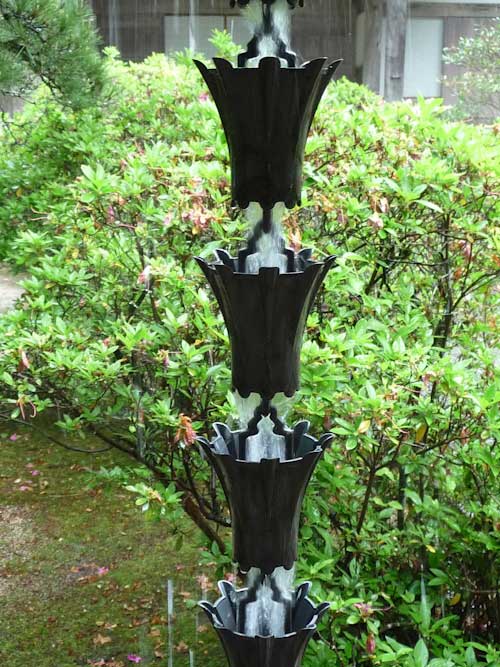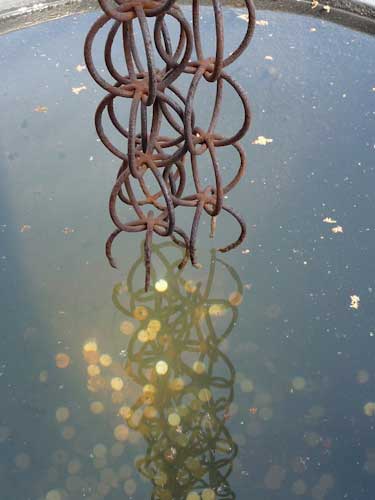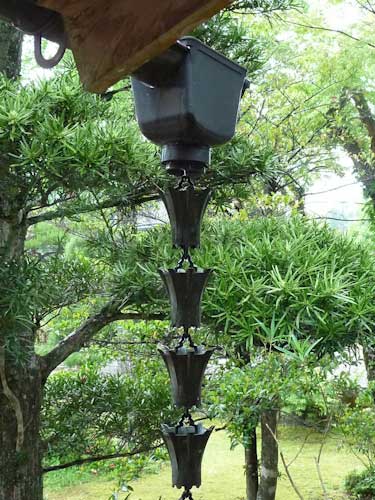Kusari-doi Rain Chains: A Beautiful and Functional Japanese Tradition

Kusari-doi rain chains are a captivating blend of art and functionality, originating from ancient Japanese architecture. These elegant alternatives to traditional downspouts have been channeling rainwater for centuries, adding a touch of tranquility to homes and gardens. As we explore the world of kusari-doi, you'll discover their rich history, diverse designs, and practical benefits. Whether you're a homeowner looking to enhance your property's aesthetics or simply fascinated by Japanese culture, kusari-doi rain chains offer a unique way to manage rainwater while creating a soothing atmosphere in your outdoor space.
What are Kusari-doi Rain Chains?
Kusari-doi, which literally translates to "chain gutter" in Japanese, are decorative chains that guide rainwater from the roof to the ground. Unlike traditional closed downspouts, kusari-doi rain chains allow water to cascade visibly, creating a mesmerizing display during rainfall. These chains typically consist of a series of cups, links, or other decorative elements that work together to control the flow of water.
Rain chains come in various materials, with copper being a popular choice due to its durability and the beautiful patina it develops over time. Other materials include aluminum, brass, and even glass, each offering unique aesthetic qualities. The design of kusari-doi can range from simple chains to intricate cups shaped like flowers, animals, or geometric patterns, allowing homeowners to choose a style that complements their home's architecture and personal taste.
The History and Cultural Significance of Rain Chains in Japan
The origins of kusari-doi rain chains can be traced back to ancient Japan, where they were first used in Japanese temples and shrines. These chains served both practical and spiritual purposes, guiding rainwater to collection basins for use in purification rituals and garden irrigation. Over time, the aesthetic appeal of rain chains led to their adoption in residential architecture, becoming a common feature in traditional Japanese homes.
In Japanese culture, the sound of water is highly valued for its calming effects. Kusari-doi rain chains contribute to this sensory experience, creating a gentle, melodious sound as water trickles down the chain during rainfall. This auditory element adds to the peaceful atmosphere of Japanese gardens and has made rain chains increasingly popular in contemporary landscape design worldwide.
Today, kusari-doi remain an important aspect of Japan House & Home architecture, symbolizing the harmonious relationship between nature and human habitation. Their growing popularity outside Japan reflects a global appreciation for both their functionality and aesthetic value.
How Kusari-doi Rain Chains Work
The functionality of kusari-doi rain chains is based on simple physics and the properties of water. When rain falls on a roof, it's collected by gutters and directed towards the rain chain. As water reaches the top of the chain, it adheres to the surface of the links or cups due to surface tension and gravity, flowing downward in a controlled manner.
For cup-style rain chains, each cup catches water from the one above it, creating a cascading effect that slows the water's descent and reduces splashing. Link-style chains rely on the water's tendency to follow the path of least resistance, clinging to the chain as it flows downward. This design not only manages water flow but also creates a visually appealing water feature during rainy weather.
At the base of the rain chain, water is typically directed into a basin, rain barrel, or specially designed landscaping feature. This allows for efficient water management and can be integrated into rainwater harvesting systems, contributing to sustainable water use practices.

Typically aligned over a soak-away drain, rain chains are attractive elements of a Japanese house and garden.
Types and Designs of Kusari-doi Rain Chains
Kusari-doi rain chains come in a wide variety of designs, catering to different architectural styles and personal preferences. Some popular types include:
- Cup Chains: These feature a series of small cups or funnels that catch and channel water downwards. Cup designs can range from simple geometric shapes to intricate floral patterns or nature-inspired motifs.
- Link Chains: Consisting of interconnected metal links, these chains offer a more minimalist look while still effectively guiding water flow.
- Combination Designs: Some rain chains incorporate both cups and links, creating unique patterns and water flow dynamics.
- Themed Chains: These may feature shapes like leaves, animals, or other decorative elements that reflect the homeowner's interests or complement the garden's theme.
Materials used in rain chain construction also vary, with each offering distinct advantages:
- Copper: Prized for its durability and the beautiful patina it develops over time.
- Aluminum: Lightweight and resistant to rust, making it ideal for coastal areas.
- Brass: Offers a golden hue and is resistant to corrosion.
- Stainless Steel: Provides a modern look and excellent durability.
When selecting a kusari-doi rain chain, consider factors such as your home's architectural style, the local climate, and the desired visual impact to choose a design that best suits your needs.

Here a Kusari-doi is made of simple, interlaced iron rings over a stone water trough used as a wishing well. Where the rings reach the water they have rusted away, indicating their age.
Benefits of Using Kusari-doi Rain Chains
Incorporating kusari-doi rain chains into your home's exterior offers numerous advantages:
Aesthetic Appeal: Rain chains add a unique, decorative element to your home's exterior. They transform the functional aspect of water drainage into an artistic feature, enhancing the overall visual appeal of your property.
Soothing Ambiance: The gentle sound of water flowing down a rain chain creates a calming atmosphere, adding a sensory dimension to your outdoor space. This can be particularly enjoyable during light rains or when relaxing on a porch or patio.
Eco-Friendly Water Management: Rain chains can be integrated with rainwater harvesting systems, allowing you to collect and reuse rainwater for gardening or other purposes. This supports sustainable water use practices and can help reduce water bills.
Low Maintenance: Compared to traditional downspouts, kusari-doi rain chains are generally easier to clean and maintain. They're less likely to clog with debris and can be easily rinsed or wiped clean when necessary.
Versatility: Rain chains can be adapted to various architectural styles and can be easily replaced or customized to suit changing preferences or needs.
Educational Value: For families with children, rain chains provide an opportunity to observe and learn about water flow and the water cycle in an engaging, visual way.
Installing and Maintaining Kusari-doi Rain Chains
Installing a kusari-doi rain chain is generally a straightforward process that can often be completed as a DIY project. Here are the basic steps:
- Remove the existing downspout from the gutter outlet.
- Install a gutter adapter or hook to securely attach the rain chain.
- Hang the rain chain from the adapter, ensuring it's properly aligned.
- Secure the bottom of the chain to prevent swaying in strong winds. This can be done by anchoring it to the ground or a decorative basin.
Maintenance of kusari-doi rain chains is relatively simple:
- Regular Cleaning: Periodically rinse the chain with water to remove dust and debris. For more thorough cleaning, use a mild soap solution and a soft brush.
- Inspect for Damage: Check the chain regularly for any signs of wear or damage, especially after severe weather.
- Winter Care: In areas with freezing temperatures, consider removing the rain chain during winter months to prevent ice damage.
It's important to note that while rain chains are effective in most conditions, they may not be suitable for areas with extremely heavy rainfall or strong winds. In such cases, consulting with a professional installer can help determine the best solution for your specific situation.

Metal or plastic cups make for attractive and functional shapes when connected as a rain chain.
Where to Find and Purchase Authentic Kusari-doi Rain Chains
For those interested in adding a kusari-doi rain chain to their home, there are several options for finding and purchasing authentic pieces:
Specialty Garden Stores: Many garden centers and outdoor living stores now carry a selection of rain chains. These outlets often have knowledgeable staff who can provide advice on selection and installation.
Online Retailers: Numerous online marketplaces and specialty websites offer a wide variety of kusari-doi rain chains. When purchasing online, be sure to read product descriptions carefully and check customer reviews to ensure quality.
Artisan Crafters: For unique, handcrafted rain chains, consider purchasing from individual artisans or small studios. These can often be found at craft fairs, art markets, or through online handmade goods platforms.
Japanese Import Stores: Stores specializing in Japanese goods may carry authentic kusari-doi imported directly from Japan. These pieces often come with a higher price tag but offer traditional craftsmanship and designs.
Home Improvement Centers: Larger home improvement stores have begun to stock rain chains as their popularity has grown. While these may offer more standardized designs, they can be a convenient and often more affordable option.
When selecting a kusari-doi rain chain, consider factors such as the material, length, and design to ensure it complements your home and meets your functional needs. Don't hesitate to ask sellers about the origin and authenticity of the product, especially if you're looking for a traditional Japanese piece.
By incorporating a kusari-doi rain chain into your home, you're not just adding a practical water management solution, but also bringing a piece of Japan's rich cultural heritage to your living space. Whether you're drawn to their aesthetic beauty, soothing sounds, or eco-friendly functionality, kusari-doi rain chains offer a unique way to enhance your home's exterior and create a more harmonious connection with nature.








